In: Feminist Art
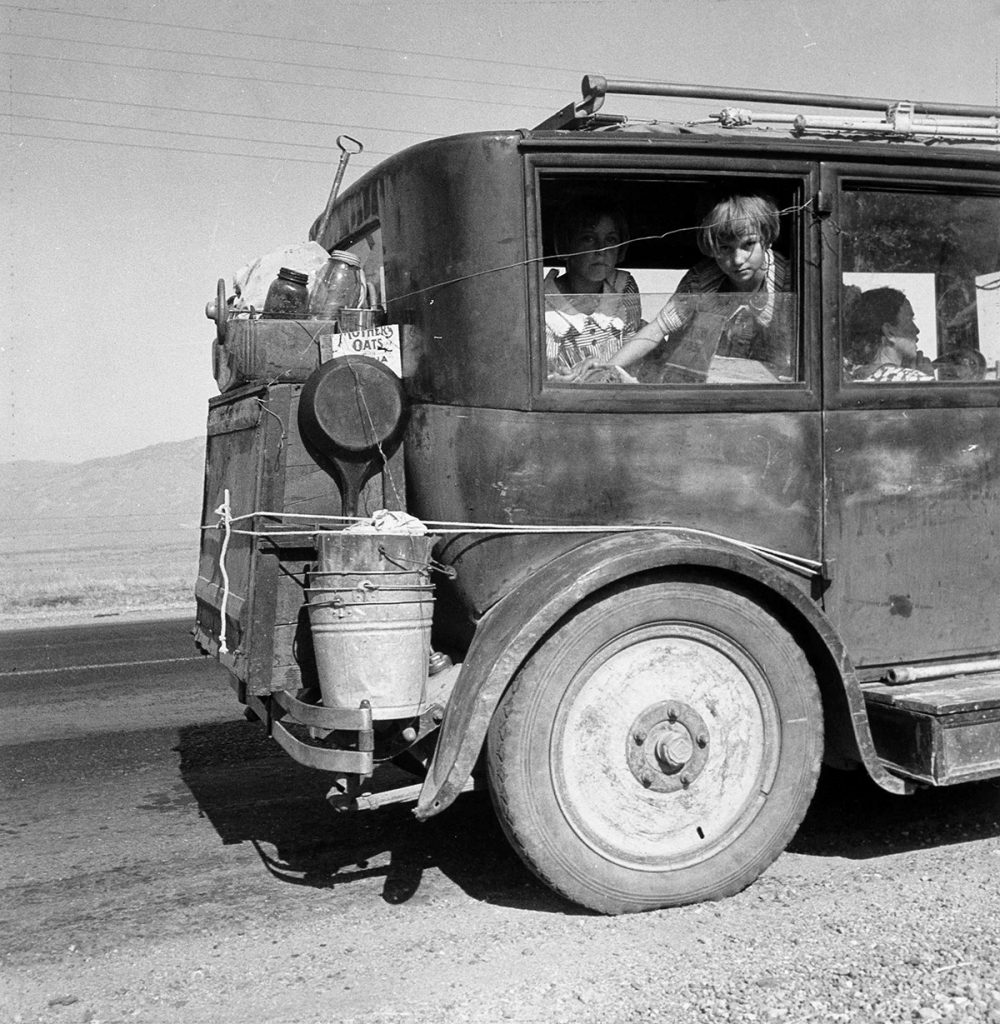
Dorothea Lange | A family of drought refugees from Abilene, Texas, on the road in California | 1936
May 4, 2023Dorothea Lange (1895 – 1965) | A family of drought refugees from Abilene, Texas, on the road in California | 1936
“The depression was making people disappear.
They vanished from factories and warehouses and workshops, the number of toilers halving, then halving again, until finally all were gone, the doors closed and padlocked, the buildings like tombs. They vanished from the lunchtime spots where they used to congregate, the diners and deli counters where they would grab coffee on the way in or a slice of pie on the way out.
They disappeared from the streets.
They were whisked from the apartments whose rents they couldn’t meet and carted out of the homes whose mortgages they couldn’t keep pace with, lending once thriving neighborhoods a desolate air, broken windows on porches and trash strewn across overgrown yards. They disappeared from the buses and streetcars, choosing to wear out their shoe leather rather than drop another dime down the driver’s metal bucket. They disappeared from shops and markets, because if you yourself could spend a few hours to build it, sew it, repair it, reline it, reshod it, reclod it, or reinvent it for some other purpose, you sure as hell weren’t going to buy a new one.
They disappeared from bedrooms, seeking solace where they could: a speakeasy, or, once the mistake of Prohibition had been corrected, a reopened tavern, or another woman’s arms—someone who might not have known their name and certainly didn’t know their faults well enough to judge them, someone who needed a laugh as badly as they did.
They disappeared, but never before your eyes; they never had that magic. It was like a shadow when the sun has set; you don’t notice the shadow’s absence because you expect it. But the next morning the sun rises, and the shadow’s still gone.”
(Thomas Mullen, The Many Deaths of the Firefly Brothers)
I have a tendency in my research to fall down rabbit holes: this is often shaped by history (my interest – which has manifested on this site – in post Soviet artists, for example) and of late The Great Depression has been a point of interest. My enjoyment of horror intersects here, so I will confess that I came to the author that I quote liberally above (whose book follows two brothers whom are bank robbers during the Great Depression, harshly factual and researched, but they find they are resurrected each time they’re killed in one of their robberies) through Daniel Knauf’s Carnivàle series. But, like another writer has pointed out, improbability and violence overflow from ordinary life, and the Great Depression was a time more, perhaps, malleable than most, as many assumptions were fractured irreparably…
And the horrors experienced by many from the Crash of 1929 through the Depression were ‘unimaginable’ to many, until they became commonplace, and now, it seems, have been forgotten. This is similar to how we forget that Lange’s subjects are not just icons but actual people who lived, suffered and died.
To many, Lange’s work requires no introduction. Many of her photographs are so stitched into the fabric of a communal history that they act as signifiers for collective memories. Nonetheless: Dorothea Lange “was an American documentary photographer and photojournalist, best known for her Depression-era work for the Farm Security Administration (FSA). Lange’s photographs influenced the development of documentary photography and humanized the consequences of the Great Depression.” (from here)
I return to Mullen’s book that had flavours of horror, but not in the way I expected, as it was more historical than ‘supernatural’ horror:
“Ten feet behind them, standing at the base of an arc light and looking in the opposite direction, was a young, balding man who Weston supposed was the father. The man looked as if he were trying very hard to become invisible.
When you bump into an old acquaintance on the street, you ask him how he’s doing. He tells you a story and then you tell him your story, and both of you are trying to see where you fit within the other’s. Your story says: This is the way the world is, and I’m the center, over here. But if the other guy tells a different story, with the world like this, where the center’s actually over here, then you realize that you’re way off to the side.
This man did not need to be told he was off to the side. He clearly realized it.”
More of Lange’s work – both her iconic images of The Great Depression and her later work that was more local but considered the same issues of justice and equality – can be seen here.
~ Bart Gazzola
Read More
Kristina Varaksina | Self portrait wrapped, 2020
April 27, 2023Kristina Varaksina | Self portrait wrapped, from the Self Reflection series, 2020
“Why do men feel threatened by women?” I asked a male friend of mine. (I love that wonderful rhetorical device, “a male friend of mine.” It’s often used by female journalists when they want to say something particularly bitchy but don’t want to be held responsible for it themselves. It also lets people know that you do have male friends, that you aren’t one of those fire-breathing mythical monsters, The Radical Feminists, who walk around with little pairs of scissors and kick men in the shins if they open doors for you. “A male friend of mine” also gives — let us admit it — a certain weight to the opinions expressed.)
So this male friend of mine, who does by the way exist, conveniently entered into the following dialogue. “I mean,” I said, “men are bigger, most of the time, they can run faster, strangle better, and they have on the average a lot more money and power.” “They’re afraid women will laugh at them,” he said. “Undercut their world view.”
Then I asked some women students in a quickie poetry seminar I was giving, “Why do women feel threatened by men?” “They’re afraid of being killed,” they said.
(Margaret Atwood, Second Words: Selected Critical Prose, 1982)
Kristina Varaksina received her Master’s in Photography from the Academy of Art University, San Francisco, in 2013. Born in Russia, Varaksina has resided in the USA since 2010 and currently divides her time between London and New York.
From here: “In her personal work, Varaksina explores the vulnerabilities, insecurities and self-search of a woman and an artist. Her work is a creative response to what’s going on in the world and her immediate environment. Through visual symbolism, carefully curated colour palettes and cinematic lighting she reflects the strongest emotions she and her subjects experience.” I would inject another line from Atwood here, in response: I’m working on my own life story. I don’t mean I’m putting it together; no, I’m taking it apart.
Varaksina gives voice to women from different ethnic, socio-economic, and cultural backgrounds, each doing their best to accept themselves as who they are and be proud of that. Varaksina sees her job as a photographer to make “ordinary” women more visible and therefore, more valuable.”
Varaksina has earned numerous awards for her work: her figures alternate between an unflinching gaze that challenges – perhaps unnerves – the viewer, and a stillness where our presence is neither requested or needed, intruding into the quiet being of her subjects. The Self Reflection series – which is ongoing – has been described as both ‘claustrophobic’ and a commentary on the history of portraiture in the Western canon. In this body of work, her stare is direct and unrelenting, as she not only turns her camera on herself as part of her work about women but turns her gaze upon us, too.
More of her work can be seen here. Varaksina’s IG is @kristinavaraksina
~ Bart Gazzola
Read More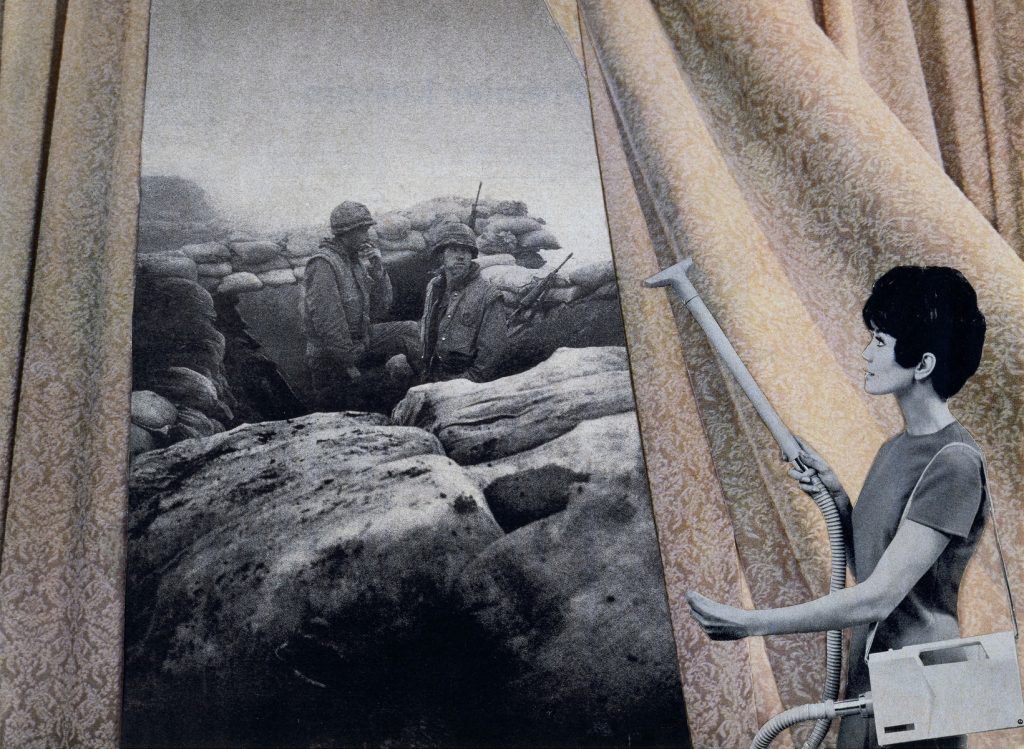
Martha Rosler | House Beautiful: Bringing the War Home, 1967–1972
March 24, 2023Martha Rosler | House Beautiful: Bringing the War Home, 1967–1972
Cotton’s generation grew up with a war in the house. For them, games of cops and robbers and cowboys and Indians no longer satisfied the senses. A boy had but to turn a control to be totally involved in the violent distension of experience that was Vietnam on television. Cotton became addicted to it. Vietnam was even a portable war.
A boy had but to move his personal set to have air strikes in the living room, search-and-destroy operations in the bedroom, naval bombardment in the bathroom—napalm before school, body bags before dinner.
(Glendon Swarthout, Bless the Beasts and the Children)
I recently read The Sacred Lies of Minnow Bly by Stephanie Oakes. The premise – of a young woman who survives a doomsday cult – sent me down a rabbit hole, if you will, of research on these cults, and since then I’ve been devouring a number of texts on the topic.
One of these – Jeffrey Melnick, Charles Manson’s Creepy Crawl: The Many Lives of America’s Most Infamous Family – offers an interesting supposition. Melnick argues that the Tate – LaBianca murders were used by many on the right – Nixon, for example – as a means by which to shutter debate about the (even then) failure of the nuclear family in the United States. This is similar to Zizek’s comment that most conversations about socialism always have a chicken little proclaiming it ‘will end in the gulag!’. Other societal issues are cast in a different light from the Manson murders, as well (for example, Melnick talks about the dismissive attitude towards runaways – especially girls – at that time, criminalizing or infantilizing them, using several of the Manson ‘family’ as examples, instead of focusing on larger issues within society).
Melnick dismisses with derision the idea that Manson ‘ended’ the supposed utopic dream of the 1960s – and for this post, a point he makes stays with me. Bluntly, that the violence of the Manson family was nary a drop in the bucket to the televised, sanctioned and officially endorsed violence of the war in Vietnam and other societal pressures. His words: “If the countercultural fabric got torn it was not because a few celebrities were killed in August of 1969. We would be better off attending to the plight of returning veterans, the not unconnected influx of harder drugs into American cities, the ongoing runaway crisis, and a major effort by the dominant culture—from the president on down—to repudiate and abandon young people and their culture.”
And this brings us to Martha Rosler’s series House Beautiful: Bringing the War Home, 1967–72.
The initial incarnation of this series was about Vietnam: in a despairing commentary about history Rosler would revisit and reinterpret it decades later, for the ‘war against terror’ in Iraq and Afghanistan…..
Rosler – in the tradition of artists like Hannah Höch – employs collage, using images that are familiar to us in tandem with others that fracture and trouble the original ‘homes’ on display. These might ‘homes’ in the literal sense, but also the ideologies and assumptions that inform those spaces, sometimes so implicitly that to highlight them engenders a denial of them, like a fish unaware of water as it’s so ubiquitous.
‘This work is one of twenty pieces from Rosler’s House Beautiful: Bringing the War Home (c.1967-72) series created during, and influenced by, the Vietnam War. It was the first war in history that was literally brought into the homes of American people through the revolutionary new television set from which its horrors could be witnessed daily. It was often described as a “living room war” – a description loaded with strange poignancy as it shined a light on the eeriness of a nation living their everyday lives, ripe with consumerist concerns like keeping the stylish home drapes clean, all the while gruesome political realities took place elsewhere, becoming just another form of nightly entertainment in front of the tube.
Simultaneously, there is a feminist element to the work as it comments on the robotic mundaneness of female domestic work in the midst of global unrest. The idea of women striving to keep the house beautiful while war’s tragedies are omnipresent becomes almost comical, and presents a surreal picture about what we deem important. Recognizing the potential for manipulation in the photographic medium, Rosler once stated, “Any familiarity with photographic history shows that manipulation is integral to photography.”’ (from here)
More of Rosler’s extensive practice – and her roles as social critic and historian for more than half a century – can be seen here.
~ Bart Gazzola
Read More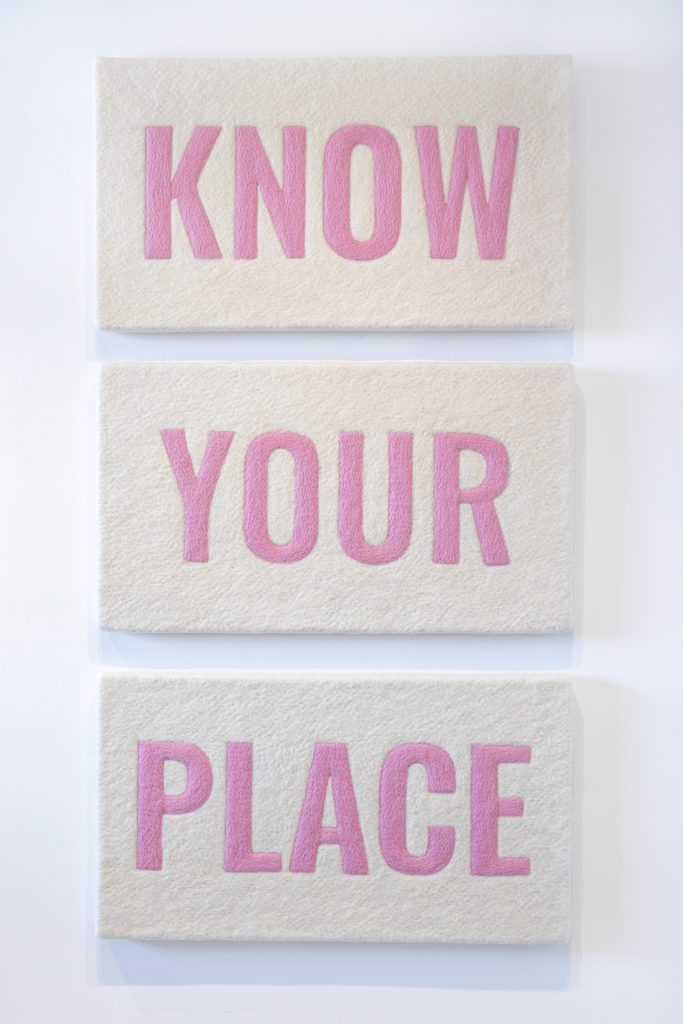
Kelly Tapìa – Chuning | More Than Once, 2022
January 20, 2023Kelly Tapìa-Chuning | More Than Once, 2022
needle felted Romney wool on foam board insulation, 27.50 x 49 x 4 inches
I could pretend I’m sorry for saying this (but I’m not, in the least), but 2023 has been off to an interesting start with the deaths of Joseph Ratzinger and Gerald Pell. Perhaps you think that’s ghoulish, but when considering the work of my latest Curator’s Pick – Kelly Chuning – I remembered that not just had both of those men aided and abetted abusers of children, but their lives and actions were drenched in misogyny. Their hatred of women who didn’t fit their own ignorance is one of the many rank stenches that they’ll leave behind, akin – if not worse – than the smell of a corpse.
If that seems ‘disrespectful’, let us consider the artwork by Tapìa – Chuning that spurred these thoughts, which were in an exhibition titled What is Respect? that was at Red Arrow Gallery in 2022.
“What is Respect? takes place two months after the Supreme Court overturned Roe V. Wade, guaranteeing a women’s right to an abortion and 5 days before abortion is completely illegal in the state of Tennessee. With this body of work, I am giving the responsibility to the viewer to decide what the term ‘respect’ implies, given the current political climate; and asking the audience to consider how we can utilize language as a tool for change going forward.
Growing up in a fiercely religious household, the people of Tennessee weighed heavy on my mind as I heard the news of the state’s trigger law (‘The Human Life Protection Act’) banning abortion with no exceptions for rape or incest. As a victim of sexual assault, the implications of this law influenced me to act immediately.” (from here)
It is necessary to remember that the voices on the Supreme Court of the United States that spewed the Dobbs decision are predominantly religious – with ‘precedent’ being ‘cited’ by one, the rabid catholic Alito, regurgitating the biliousness of a witchfinder from several centuries ago. If my writing seems caustic – or ‘disrespectful’ – it is less so than those that seek to dehumanize people like Tapìa – Chuning…..
Kelly Chuning is an interdisciplinary biracial Latinx artist currently based in northwest Montana. She received her BFA in Studio Arts from Southern Utah University and will be attending Cranbrook Academy of Art fall 2022 as a Gilbert Fellow. Chuning’s work explores rhetoric, imagery, and media as a tool of constructing various modes of female identity.
Her IG is @kelly_chuning/
Kelly Tapìa – Chuning’s site is here.
~ Bart Gazzola
Read More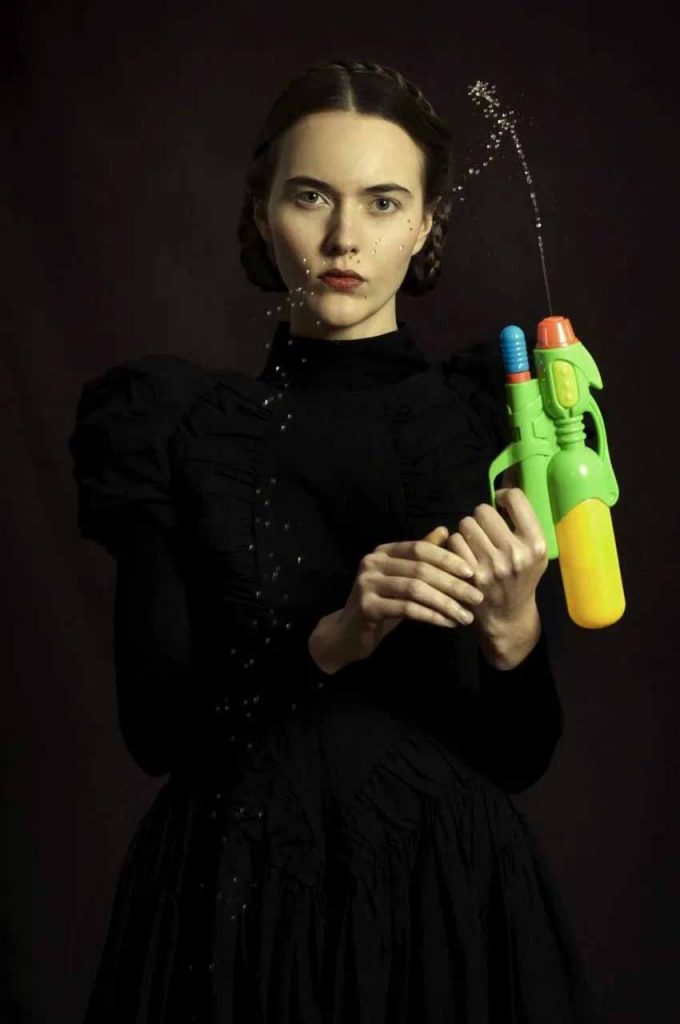
Romina Ressia | Woman with a Water Pistol, 2014
January 6, 2023Romina Ressia | Woman with a Water Pistol, 2014
Most of the writing around Ressia’s photographs talks about absurdity and anachronism: perhaps that’s because she appropriates form and redefines meaning in a manner that challenges art historical tropes around gender and relevance. Meticulously executed, her ‘portraits’ have a gravitas on the one hand, but then this is broken by elements that can’t help but amuse (though her people never crack a smile, with eye contact that might wilt any irreverence from the viewer).
There is a hint of dourness to the woman who is the player in this series, and many others, having a heavy handed seriousness that is then fractured by the various objects her subjects are brandishing that seem silly and puerile.
Bluntly, Messia’s Woman with a Water Pistol looks like she’s had just about enough of you, young man, and unless you want to be sprayed with water – disciplined like an unruly, disobedient cat – you’d best behave. You shan’t be told again.
A bit flippant perhaps. But consider the [still, uninterrupted] proliferated misogyny in Western art history [or contemporary art] of women as object, or demure commodity, or the validation / apologia of rape as seen with Europa or the Sabine women or ‘Susannah and the Elders’ (and so, so many others). Consider that in (recently done) 2022 we’ve seen groups of women around the world make it clear that they have had *quite* enough and my interpretation is not without consideration….
This image is part of a larger series titled How would have been Childhood? with the same figure in them all, her unimpressed body language acting as a unifying aspect of the artworks. Birthday hats, costumes, balloons – nothing seems to inspire joy, here. When I first encountered this series online, a birthday party that no one was enjoying – if anyone even came, besides the ‘star’ of the series – can be forgiven for being an initial impression….
“Romina’s art cleverly initiates dialogue on important contemporary social issues through the striking use of anachronistic tropes juxtaposed with mundane and banal elements of modernity. Indeed, the influence of classical artists like Da Vinci, Rembrandt and Velazquez is instantly recognizable in the palettes, textures, ambiance and scenes captured in Romina Ressia’s works, bequeathing them an air of familiarity which only serves to highlight the contradictory and sometimes confrontational presence of objects of modernity such as cotton candy, bubble gum, microwave popcorn and Coca Cola.
The theatrical absurdity in her pictorial compositions, which combine stylistic elements of Renaissance paintings and Pop art, and the dissonance of the stark contradictions captured therein have a surprising clarity, making for an honest critique through visual dialogue of received notions of modernity. In this sense, Romina succeeds in achieving her artistic intent which is not to recreate or refer to the past but to establish a frame within which to interrogate the perceived evolution and progress of society especially in respect to the role and identity of women.” (from here)
If you’re doltish enough to suggest ‘she’d look better if she smiled’, don’t be surprised if you get soaked – deservingly.
More of Romina Ressia’s evocative – if a bit disquieting – work can be seen here.
Her Instagram is @rominaressia
~ Bart Gazzola
Read More
Haruko Maeda | Self – Portrait with my cat and my grandmother in a glass, 2020
December 2, 2022Haruko Maeda | Self – Portrait with my cat and my grandmother in a glass, 2020
Several years ago, when I was going through the library of a recently deceased friend – at the invitation of his daughter – I noticed in his (former) apartment that she had a velvety bag, looking lustrous and fancy. I asked if this was some expensive alcohol, to mark her father’s passing. She told me it was her father’s ashes. When I asked if they’d be scattered in the city we were in, as he’d lived there for some time, contributing to the critical writing community and being a significant voice around visual culture and especially photography, or back in his home province in the Maritimes, she tersely commented she had not decided yet whether they’d be flushed down the toilet or mixed in with the cat litter.
When my own father passed several years ago, not long before COVID, the arrangements around his inurnment were put on hold: his ashes sat on a shelf in the living room of what is now my mother’s house for some time, only recently being put underground this past summer. Frankly, having ‘him’ in the same room where he spent most of the final years of his life seemed to comfort my mother: he was more agreeable than he’d been in decades, ahem.
No, I am not smiling – my face is as stoic and unreadable as Maeda’s, in her painting.
Those are both dark places to begin in considering Haruko Maeda’s painting Self – Portrait with my cat and my grandmother in a glass: but the funerary rites and rituals of family are nothing if not contested narratives that bring feelings to the surface, re opening old wounds and making new ones. Leave the dead to bury the dead, they (Matthew and Luke, to be specific, but that may just be hyperbole) say, but they never truly ‘leave’ us….
Maeda looks unperturbed in this scene: her cat seems relaxed, and even the fly that perches upon her arm that holds the ashes of her grandmother is subtle.
“Japanese Haruko Maeda lives and works in Austria since 2005. In her art she combines the Shintoistic traditions of her homeland with the Roman Catholic faith, deeply rooted in Austrian culture and history. This allows her to position herself between East and West. Maeda lets these double belongings function as a kind of filter through which she can process her own memories and experiences. The purpose is to raise universal questions about existence, life and death.” (from here)
In Neil Gaiman’s Sandman series, the final story arc – The Wake – offers several vignettes as concluding narratives about death, loss and mourning. One of these involves a man cast into exile, after the death of his son, who gets lost in a desert that his guides will not name, as to do so is to invite disaster. Master Li finds a tiny kitten as a companion, a ward, perhaps, against the ghosts of the dead he encounters in the ashy, shifting sands. At some point he encounters the shade of his son, and this is their conversation:
“Father? I am your son. That is only a kitten. Why do you abandon me to chase after it?”
“When you were alive, you were all my joy. Now you are dead. I see you only in my dreams. And when I awake my pillow is wet with tears. The kitten is living, and it needs my help.”
There is a solemnity to Maeda’s work, but also just a touch of irreverence.
More of Haruko Maeda’s work can be seen here.
~ Bart Gazzola
Read More
Jane Evelyn Atwood | TOO MUCH TIME: WOMEN IN PRISON, 2000
November 25, 2022Jane Evelyn Atwood, TROP DE PEINES: FEMMES EN PRISON, 2000, Éditions Albin Michel, Paris, France. (OUT OF PRINT)
Jane Evelyn Atwood, TOO MUCH TIME: WOMEN IN PRISON, 2000, Phaidon Press Ltd., London, England. (OUT OF PRINT)
“Curiosity was the initial spur. Surprise, shock and bewilderment soon took over. Rage propelled me along to the end.”
Too many times – and I’m sure I’m not alone in this – I have heard some well meaning dilettante assert that ‘art should be about beauty’ or ‘should only uplift us.’ In terms of that space where photography intersects with ideas of art and documentary – and not to mention history – something that comforts you is most likely wrong, if not simply pablum. When I’m sharing images on social media, there are some photographers I hesitate to post works from (as photography still carries the weight of being more ‘real’, thus can ‘offend’ as well as see yourself banned from those platforms): Gilles Peress is one of those, for his unflinching lens in places from Rwanda to the former Yugoslavia (“I don’t trust words. I trust pictures”), Gordon W. Gahan (specifically his images of the Vietnam War), Donna Ferrato (I was lucky enough to experience her groundbreaking series Living with the Enemy decades ago, in Windsor) or Martha Rosler (her House Beautiful: Bringing the War Home works that had their genesis in response to the Vietnam War (c.1967–72) but that she ‘revisited’ in 2004 and 2008, ‘updating’ them to Iraq and Afghanistan).
But the text I’ve selected for a Library Pick is something that is not ‘there’ but ‘here’, and in that respect is often – easily, repeatedly – ignored.
Jane Evelyn Atwood’s “monumental work on female incarceration, published in both French and English, took Atwood to forty prisons in nine different countries in Europe, Eastern Europe, and the United States. The access she managed to obtain inside some of the world’s worst penitentiaries and jails, including death row, make this ten-year undertaking the definitive photographic work on women in prison to date. Extensive texts include interviews with inmates and prison staff as well as Atwood’s own reminiscences and observations. The prize-winning photos in this book, including the story of an incarcerated woman giving birth while handcuffed, established Jane Evelyn Atwood as one of today’s leading documentary photographers.” (from her site)
Atwood has always used her camera as a means to tell stories too often not even dismissed but denied, and she has granted a level of dignity and consideration to those whom are too often not considered human but detritus.
A good friend is a theologian, but of the liberation theology vein: I enjoy talking with them, as their righteous anger is only matched by their ability to quote that repeatedly translated and edited text with a sense of the public good. I mention them as they once pointed out that in the New Testament, only one person was promised a place in the ‘kingdom of heaven’, and that was one of the criminals being crucified at the same time as Jesus.
In a more modern sense, I might cite Lutheran Minister (and ‘public theologian’) Nadia Bolz-Weber‘s contemporary addendum to the beatitudes, which include ‘Blessed are those who have nothing to offer. Blessed are they for whom nothing seems to be working.’
Atwood published ten books of her work and been awarded the W. Eugene Smith Grant in Humanistic Photography, the Grand Prix Paris Match for Photojournalism, the Oskar Barnack Award, the Alfred Eisenstadt Award and the Hasselblad Foundation Grant twice.
More of Atwood’s work can be seen here.
Like several of the books I’ve recommended, this is one I came across in my local library.
~ Bart Gazzola
Read More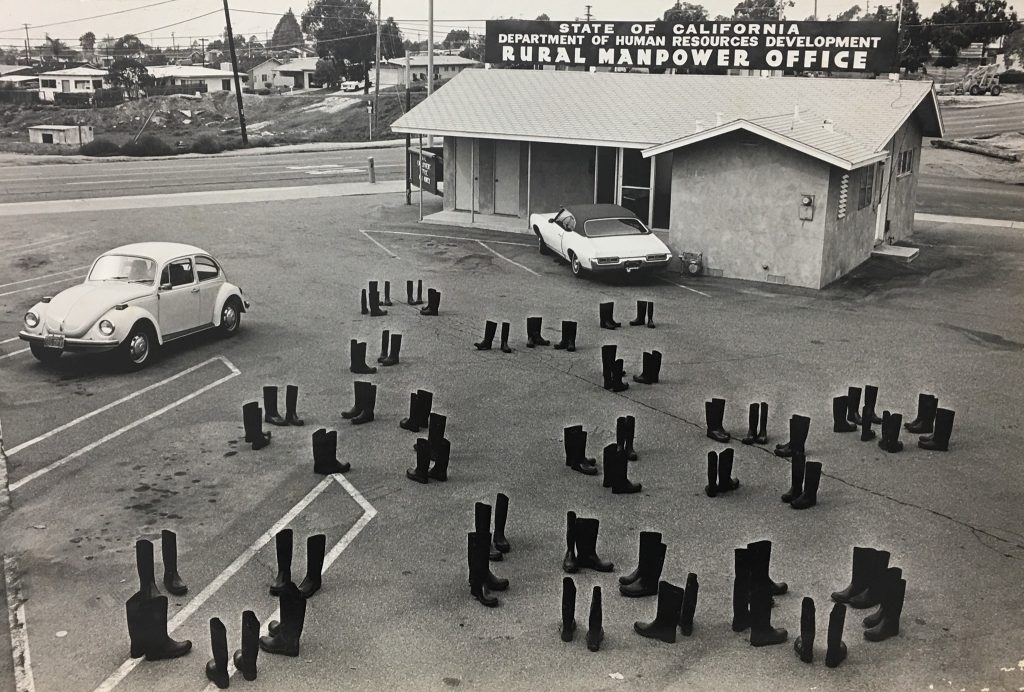
Eleanor Antin | 100 Boots, 1971-73
October 28, 2022Eleanor Antin | 100 Boots, 1971-73
“For month after month after month, her five-score empty rubber boots had to be carted across the country, set up in various evocative spots, and then photographed before someone could come along and chase Antin away…at the time, the empty boots would have had immediate resonance as a reference to the Vietnam War, and to the boot-wearers who would never come home.” (Blake Gopnik)
Eleanor Antin is an artist who has not, in my opinion, received the credit she merits for her performative installations and photographs that have a cinematic quality. At the risk of being flippant, if Gopnik, Camille Paglia and I myself all agree as to her importance, we surely can’t be wrong. Antin has been making work since the 1960s, and her art often intersects with politics in both overt and covert ways.
From Paglia’s Glittering Images: A Journey through Art from Egypt to Star Wars: ‘As a work of Conceptual art, 100 Boots consisted of temporary on-site sculptural installations documented by photographs (taken by Philip Steinmetz), which were sent uninvited to a distant, dispersed audience. The formal, squadron-like patterns assumed by the boots parody the frigid geometries then being made by male Minimalist sculptors. In their outdoor placement, the boots evoke traditional landscape painting as well as the new genre of land art, which was just emerging from Minimalism. Antin strategically varied the look of the cards so that “seductively beautiful” images were not the rule. Most of them have a bleak desolation reminiscent of existential European art films. Indeed, Antin saw the work as “a movie composed of still photos”.’
Over her career, Antin ‘has utilized a staggering range of styles, media, and materials, and her work has combined theater, dance, literature, drawing, painting, sculpture, crafts, photography, video, and architecture. “All artworks are conceptual machines,” she said. And again: “All art exists in the mind.” Antin deeply influenced the emergence of both performance art and Conceptual photography.’
For myself, these images are about the insidious nature of loss, especially as it pertains to those who have died during the pandemic. Empty boots that take on the nature of ghosts that appear in any place at any time, a simple – almost banal, like a rubber boot – fact of absence that hits you like a hammer to the chest and requires you to sit down to consider it….
Eleanor Antin was a previously featured Artist You Need To Know, in AIH Studios’ continuing series. That can be enjoyed here.
More works from this series can be seen here.
~ Bart Gazzola
Read More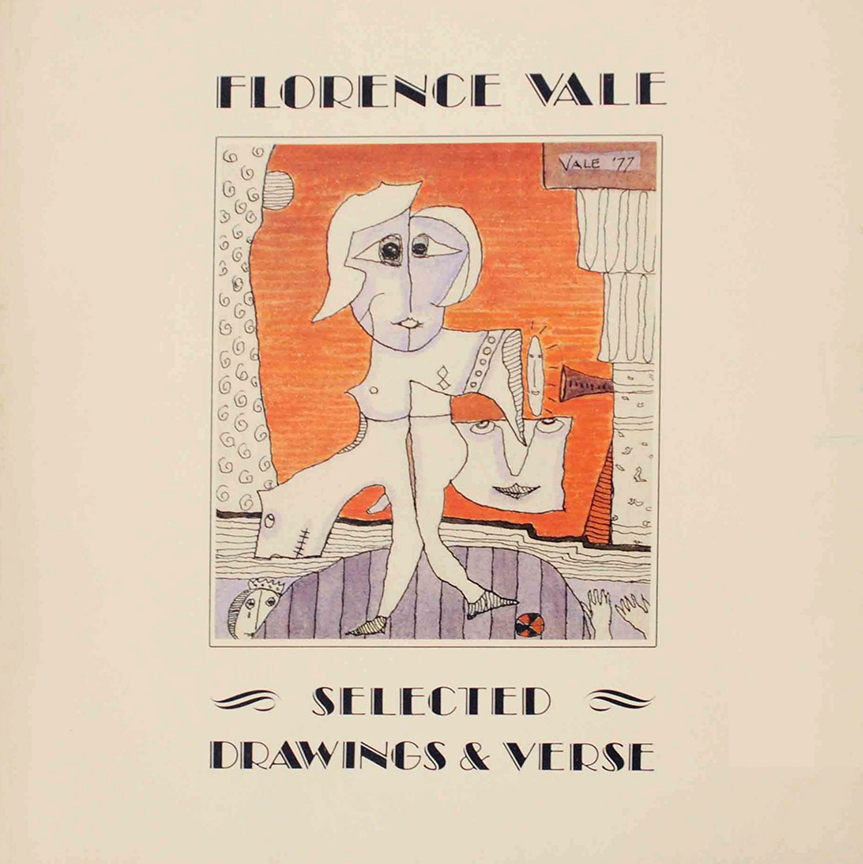
Florence Vale | Selected Drawings & Verse, 1979
November 3, 2022Florence Vale | Selected Drawings & Verse, 1979
Published by Aya Press, Toronto, Ontario, Canada, 1979
My love created
something more real than you are
how disappointing
Florence Vale was an artist influenced equally by surrealism, expressionism and cubism, melding these sometimes disparate movements into unique works. “I paint what I dream,” Florence Vale (1909 – 2003) stated, and the late art historian Natalie Luckyj offered that “Her art was a world in which fantasy and reality are interwoven to create a private and secret environment.”
She published several books of her writing intermixed with her artwork: in this slim volume, the drawings are linear and simple, and often erotic. The text alternates between a light-hearted salaciousness and more stark, desolate meditations upon love.
Vale was a previously featured artist in AIH Studios’ ongoing series of Artists You Need To Know. That can be enjoyed here, where you can see more of her artwork.
A light went out
and I can’t turn it on
the dark is frightening
engulfing
temptation is rife
a momentary relief
leaving regrets
and the pain is there still
but deeper now
despair strains the heart
longing is agony
God’s love cannot compensate for yours
This is not an easy book to find, though you may be able to procure it online through spaces like this one. But – as I so often do – I would suggest your local library, or a local second hand book store, as they have been – and continue to be – treasure troves of fine art books. I discovered this book in the library at AIH Studios, but also have a copy of another of Vale’s publications of prose and pictures that I bought at an artist run centre’s ‘yard sale.’
I must also inject that there are too few collections of artists’ books and publications that are accessible to all, in gallery and museum spaces, and this is an unfortunate consequence of the prevalence of digital spheres, now….
~ Bart Gazzola
Read More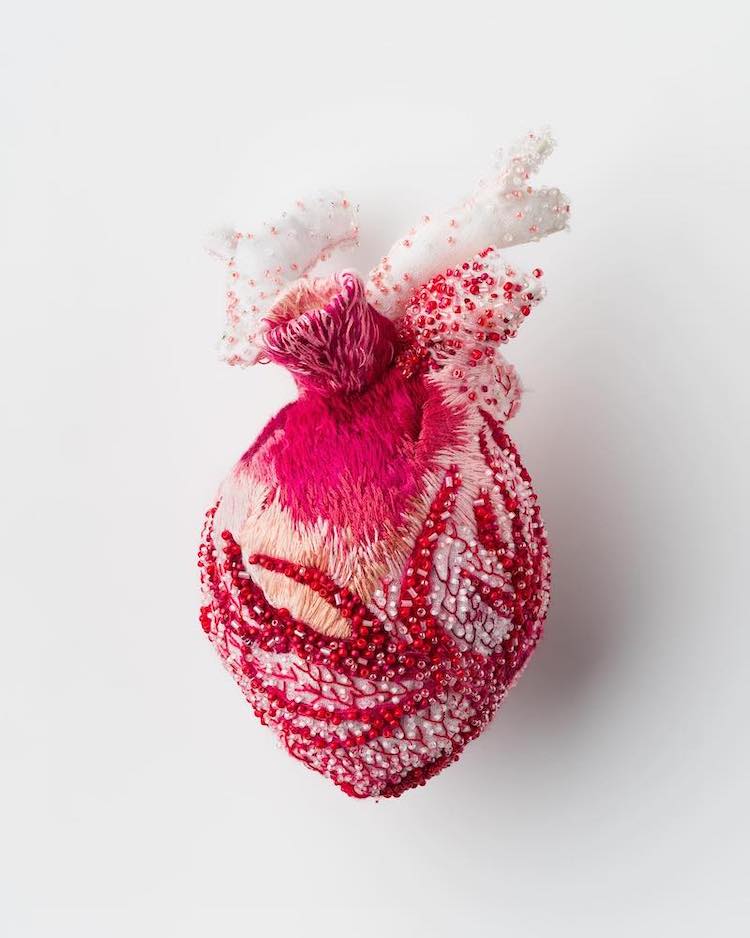
Ema Shin | Hearts of Absent Women
August 26, 2022Ema Shin | Hearts of Absent Women
…as empty as an unremembered heart.
(Mervyn Peake, from his Gormenghast Trilogy)
I was born in Japan and grew up in a traditional Korean Family. My grandfather kept a treasured family tree book for 32 generations, but it only included male descendants’ names, not daughters. In my art, I have always tried to celebrate women and their historical handcrafts. These sculptural hearts are made from embroidery, handwoven tapestry, and papier mâché to recognize and celebrate the silent behind-the-scenes domestic duties of women and represent not only her emotions but serve as offerings or amulets for her protection.
(Ema Shin’s words, from here)
Of late, I’ve been watching the series Motherland: Fort Salem. I’ve a weakness – if you wish to put it that way, but I prefer affinity – for science fiction and fantasy (something I’ve been told, along with my interest in horror, is ‘inappropriate’ for an arts journalist…you know, like how the ‘only real art is painting’, ahem, to cite some of the karaoke modernists I endured on the prairies). The ‘alternate worlds’ are what interest me. When I was consuming William Gibson’s books, I was always more fascinated by the subtle things in his stories, presented as more factual and less chimeric (that the USSR eventually – for all intents and purposes – is run by the ‘criminal’ Kombinant, with the Russian mafia having fully taken over the government, that a religious cult appears that believes god speaks to them through movies – only from a certain era, of course – or that another character makes a living testing logos and brands, as she has an immediate, allergic reaction to any kind of advertising…)
In Motherland, a different world exists than that which we occupy: one where the Salem Accords have forged an uneasy alliance between the Witches of Salem and the United States Government, playing out in contemporary times. Imagine a military industrial complex based upon the magic of witches (or more accurately, the power of women), and – this is the part that is of more interest to me – a society that has formed around that, marking a genesis even before the United States became the United States, that is very matriarchal. Small things stood out to me, about how social ‘norms’ and customs play out very differently in this ‘world’ than in our own, especially around sexuality, power, who is expected to lead and who is expected to follow, and how history – in Salem – is overtly defined by a female gaze, if you will. I say ‘overtly’, as I always remember Martha Langford’s Suspended Conversations: The Afterlife of Memory in Photographic Albums, and those outside the frame who define it, but still are unseen metaphorically as well as literally…..
Ema Shin is a Melbourne based artist who was born and grew up in Niigata, Japan: she studied traditional and contemporary Japanese printmaking in Tokyo and completed a Master of Fine Art Degree in Nagoya. Shin has exhibited widely in Japan, Korea, Australia and elsewhere. Prior to this series, Shin focused on a variety of printmaking techniques and mediums, including Japanese woodblock printing, papier-mâché, embroidery, book making, Urauchi (chine-colle) and collage.
This interest in the physicality of materials continued when, due to motherhood and the pandemic, Shin “began to explore tapestry and embroidery…her red embroidered organs and [three dimensional] human hearts are beautiful to look at, and deeply personal-political in meaning.” (from here)
These are the archival giclée prints of the delicate objects Shin has created as part of her Hearts of Absent Women series (all photographs are by Matthew Stanton), and are an edition of 50.
From her site (which has many of her other fine works, so I encourage you to explore it): “Shin aims to create compositions that express sensitivity for tactile materials, the contemporary application of historical techniques, physical awareness, femininity and sexuality to celebrate women’s lives and bodies.”
Her Instagram is @ema.shin.
~ Bart Gazzola
Read More
Recent Comments